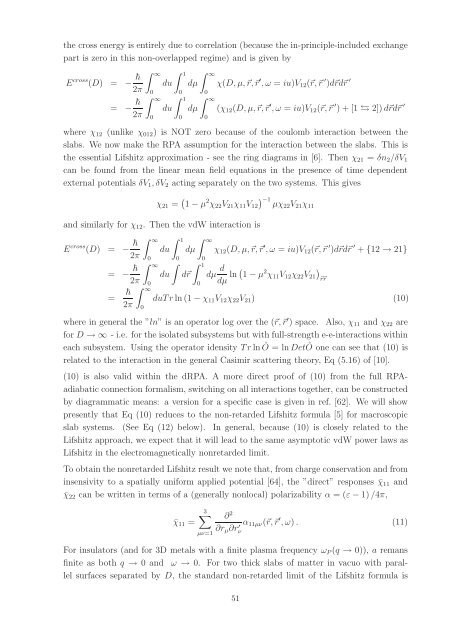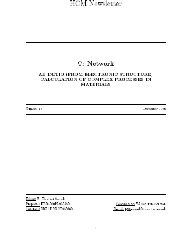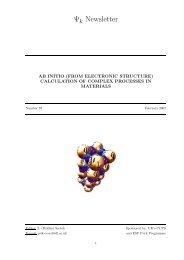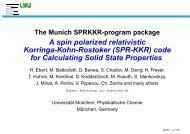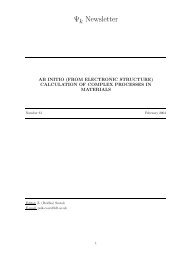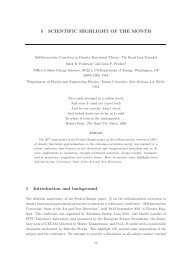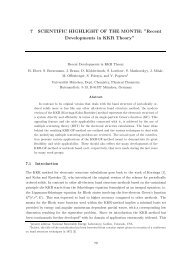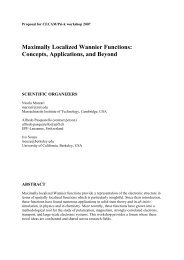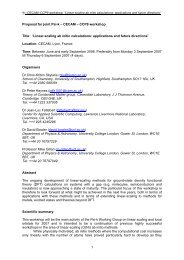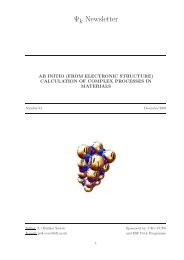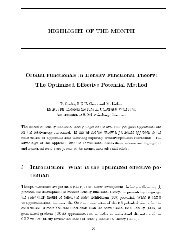Newsletter 107 - October 2011 - (pdf - 0.6 MB) - Psi-k
Newsletter 107 - October 2011 - (pdf - 0.6 MB) - Psi-k
Newsletter 107 - October 2011 - (pdf - 0.6 MB) - Psi-k
Create successful ePaper yourself
Turn your PDF publications into a flip-book with our unique Google optimized e-Paper software.
the cross energy is entirely due to correlation (because the in-principle-included exchange<br />
part is zero in this non-overlapped regime) and is given by<br />
E cross (D) = − <br />
2π<br />
= − <br />
2π<br />
∫ ∞<br />
0<br />
∫ ∞<br />
0<br />
du<br />
du<br />
∫ 1<br />
0<br />
∫ 1<br />
0<br />
dµ<br />
dµ<br />
∫ ∞<br />
0<br />
∫ ∞<br />
0<br />
χ(D, µ,⃗r,⃗r ′ , ω = iu)V 12 (⃗r,⃗r ′ )d⃗rd⃗r ′<br />
(χ 12 (D, µ,⃗r,⃗r ′ , ω = iu)V 12 (⃗r,⃗r ′ ) + [1 ⇆ 2]) d⃗rd⃗r ′<br />
where χ 12 (unlike χ 012 ) is NOT zero because of the coulomb interaction between the<br />
slabs. We now make the RPA assumption for the interaction between the slabs. This is<br />
the essential Lifshitz approximation - see the ring diagrams in [6]. Then χ 21 = δn 2 /δV 1<br />
can be found from the linear mean field equations in the presence of time dependent<br />
external potentials δV 1 , δV 2 acting separately on the two systems. This gives<br />
χ 21 = ( 1 − µ 2 χ 22 V 21 χ 11 V 12<br />
) −1<br />
µχ 22 V 21 χ 11<br />
and similarly for χ 12 . Then the vdW interaction is<br />
E cross (D) = − <br />
2π<br />
= − <br />
= <br />
2π<br />
2π<br />
∫ ∞<br />
0<br />
∫ ∞<br />
0<br />
∫ ∞<br />
0<br />
∫ 1<br />
du<br />
∫<br />
du<br />
0<br />
dµ<br />
d⃗r<br />
∫ ∞<br />
0<br />
∫ 1<br />
0<br />
χ 12 (D, µ,⃗r,⃗r ′ , ω = iu)V 12 (⃗r,⃗r ′ )d⃗rd⃗r ′ + {12 → 21}<br />
dµ d<br />
dµ ln ( 1 − µ 2 χ 11 V 12 χ 22 V 21<br />
)⃗r⃗r<br />
duTr ln (1 − χ 11 V 12 χ 22 V 21 ) (10)<br />
where in general the ”ln” is an operator log over the (⃗r,⃗r ′ ) space. Also, χ 11 and χ 22 are<br />
for D → ∞ - i.e. for the isolated subsystems but with full-strength e-e-interactions within<br />
each subsystem. Using the operator idensity Tr ln Ô = ln DetÔ one can see that (10) is<br />
related to the interaction in the general Casimir scattering theory, Eq (5.16) of [10].<br />
(10) is also valid within the dRPA. A more direct proof of (10) from the full RPAadiabatic<br />
connection formalism, switching on all interactions together, can be constructed<br />
by diagrammatic means: a version for a specific case is given in ref. [62]. We will show<br />
presently that Eq (10) reduces to the non-retarded Lifshitz formula [5] for macroscopic<br />
slab systems. (See Eq (12) below). In general, because (10) is closely related to the<br />
Lifshitz approach, we expect that it will lead to the same asymptotic vdW power laws as<br />
Lifshitz in the electromagnetically nonretarded limit.<br />
To obtain the nonretarded Lifshitz result we note that, from charge conservation and from<br />
insensivity to a spatially uniform applied potential [64], the ”direct” responses ¯χ 11 and<br />
¯χ 22 can be written in terms of a (generally nonlocal) polarizability α = (ε − 1)/4π,<br />
¯χ 11 =<br />
3∑<br />
µν=1<br />
∂ 2<br />
α<br />
∂r µ ∂r ν<br />
′ 11µν (⃗r,⃗r ′ , ω) . (11)<br />
For insulators (and for 3D metals with a finite plasma frequency ω P (q → 0)), a remans<br />
finite as both q → 0 and ω → 0. For two thick slabs of matter in vacuo with parallel<br />
surfaces separated by D, the standard non-retarded limit of the Lifshitz formula is<br />
51


